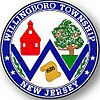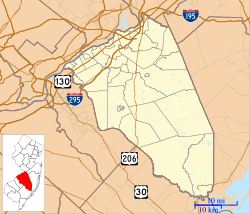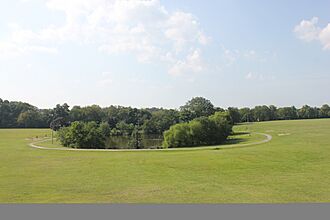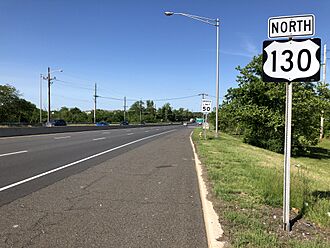Willingboro Township, New Jersey facts for kids
Quick facts for kids
Willingboro Township, New Jersey
|
||
|---|---|---|
|
Township
|
||
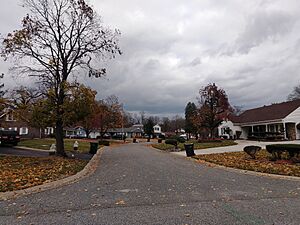
Tempest Lane, a typical residential street in Willingboro
|
||
|
||
| Motto(s):
"A Naturally Better Place to Be"
|
||
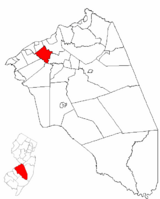
Location of Willingboro Township in Burlington County highlighted in red (right). Inset map: Location of Burlington County in New Jersey highlighted in red (left).
|
||
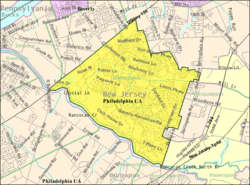
Census Bureau map of Willingboro Township, New Jersey
|
||
| Country | ||
| State | ||
| County | ||
| Formed | November 6, 1688 | |
| Incorporated | February 21, 1798 | |
| Renamed | November 3, 1959 to November 5, 1963 as Levittown Township | |
| Named for | Wellingborough | |
| Government | ||
| • Type | Faulkner Act (council–manager) | |
| • Body | Township Council | |
| Area | ||
| • Total | 8.14 sq mi (21.08 km2) | |
| • Land | 7.73 sq mi (20.01 km2) | |
| • Water | 0.41 sq mi (1.07 km2) 5.09% | |
| Area rank | 230th of 565 in state 22nd of 40 in county |
|
| Elevation | 30 ft (9 m) | |
| Population
(2020)
|
||
| • Total | 31,889 | |
| • Estimate
(2023)
|
32,122 | |
| • Rank | 73rd of 565 in state 3rd of 40 in county |
|
| • Density | 4,128.0/sq mi (1,593.8/km2) | |
| • Density rank | 151st of 565 in state 6th of 40 in county |
|
| Time zone | UTC−05:00 (Eastern (EST)) | |
| • Summer (DST) | UTC−04:00 (Eastern (EDT)) | |
| ZIP Code |
08046
|
|
| Area code(s) | 609 and 856 | |
| FIPS code | 3400581440 | |
| GNIS feature ID | 0882099 | |
| Website | ||
Willingboro Township is a community in Burlington County, New Jersey. It's a suburb located near Philadelphia. From 1959 to 1963, it was known as Levittown or Levittown Township.
Willingboro has a long history, dating back to the 1600s when British settlers arrived. In the 1950s and 1960s, a company called Levitt and Sons bought land here. They built a large, planned community, much like their other "Levittown" projects.
According to the 2020 United States census, about 31,889 people live in Willingboro. This was a small increase from the 2010 census. Over time, Willingboro became a community where many African American families chose to live.
Contents
History of Willingboro Township
Willingboro was one of the first areas organized in Burlington County, New Jersey. It was first called the "Constabulary of Wellingborrow" on November 6, 1688. This name came from Wellingborough, a town in England. That was the hometown of Thomas Olive, who led the first settlers here.
The community officially became "Willingborough Township" on February 21, 1798. This makes it one of New Jersey's oldest townships. Over the years, some parts of Willingboro became other towns. These include Beverly and Delanco Township.
The Levittown Era
In the 1950s and 1960s, a company called Levitt & Sons built many homes in Willingboro. This was their third and largest "Levittown" development. The company bought most of the land in Willingboro. A historic area called Rancocas was moved to Westampton Township. This was done so Levitt could build all the new homes within one town's borders. The first Levittown homes were sold in June 1958.
The town's name changed to "Levittown Township" on November 3, 1959. This was decided by a vote of the people living there. However, there was some confusion because another Levittown was nearby in Pennsylvania. So, on November 5, 1963, another vote changed the name back to Willingboro. The vote was very close!
The new homes brought many people to Willingboro. The population grew from 852 people in 1950 to 11,861 in 1960. By 1970, there were 43,386 residents.
Fighting for Fair Housing
When Levittown homes were first sold in 1958, the company had a rule. They would not sell homes to African American families. W. R. James, an African American Army officer, wanted to buy a home. He was told that the new community would be only for white families.
Mr. James decided to take action. He learned that it was against the law in New Jersey to refuse to sell homes based on race. This was especially true for homes that received help from the government. Mr. James sued the company. His case went all the way to the New Jersey Supreme Court. The court ruled in his favor.
Because of this ruling, Charles and Vera Williams became the first African American family to move into Willingboro in 1960. Mr. James also moved into the community later that year. He became a leader in the local NAACP group. An elementary school in Willingboro is now named after him.
After the court case, Levitt & Sons worked to make sure everyone could buy a home. They created a special committee to help with this. This committee worked to prevent problems and help different groups get along.
Over time, more African American families moved to Willingboro. By 1970, about 11% of the population was African American. In the 1970s, some real estate agents tried to scare homeowners into selling their houses cheaply. This was called "blockbusting." Willingboro tried to stop this practice by making a rule against "for sale" signs. However, the Supreme Court later said this rule went against free speech.
Geography and Parks
Willingboro Township covers about 8.14 square miles (21.08 square kilometers). Most of this is land, with a small amount of water.
The township shares borders with several other towns in Burlington County. These include Burlington Township, Delanco Township, and Mount Laurel Township. The Rancocas Creek flows through Willingboro and forms part of its border. U.S. Route 130 is a major road that runs along the edge of the township.
Willingboro's Parks and Sections
Willingboro is special because it's divided into many sections called "parks." Each park has street names that start with the same letter as the park's name. For example, all streets in Pennypacker Park begin with "P." Some older streets kept their original names, like Charleston Road.
Years ago, each park had its own swimming pool for residents. Families could get free swim passes. These pools were also used for swimming lessons and other summer activities. Today, only the pools in Pennypacker Park and Country Club Park are still open as "community pools."
Here are some of the parks in Willingboro:
- Buckingham Park
- Country Club Ridge (built around a golf course)
- Pennypacker Park
- Millbrook Park
- Martin's Beach
- Deer Park
- Somerset Park
- Windsor Park
- Garfield Park
- Garfield Park East
- Garfield Park North
- Rittenhouse Park
- Twin Hill Park
- Ironside Court (for public works and businesses)
- Hawthorne Park
- Fairmount Park
Most of Willingboro uses area code 609, but a small part uses area code 856.
Willingboro's Climate
Willingboro has a humid subtropical climate. This means it has warm, humid summers and mild winters. Average temperatures range from about 33°F (0.5°C) in January to 76.5°F (24.7°C) in July.
Population and People
Willingboro's population has changed a lot over the years. It grew very quickly in the 1960s when many new homes were built.
| Race / Ethnicity (NH = Non-Hispanic) | Pop 2000 | Pop 2010 | Pop 2020 | % 2010 | % 2010 | % 2020 |
|---|---|---|---|---|---|---|
| White alone (NH) | 7,560 | 4,690 | 3,678 | 22.90% | 14.83% | 11.53% |
| Black or African American alone (NH) | 21,616 | 22,325 | 21,940 | 65.49% | 70.58% | 68.80% |
| Native American or Alaska Native alone (NH) | 87 | 82 | 81 | 0.26% | 0.26% | 0.25% |
| Asian alone (NH) | 553 | 618 | 602 | 1.68% | 1.95% | 1.89% |
| Pacific Islander alone (NH) | 12 | 10 | 24 | 0.04% | 0.03% | 0.08% |
| Some Other Race alone (NH) | 126 | 121 | 295 | 0.38% | 0.38% | 0.93% |
| Mixed Race or Multi-Racial (NH) | 1,056 | 1,046 | 1,504 | 3.20% | 3.31% | 4.72% |
| Hispanic or Latino (any race) | 1,998 | 2,737 | 3,765 | 6.05% | 8.65% | 11.81% |
| Total | 33,008 | 31,629 | 31,889 | 100.00% | 100.00% | 100.00% |
In 2020, the township had 31,889 people. There were 10,884 households, with many families living together. The average household had about 2.9 people. About 23.5% of the population was under 18 years old. The median age was 41 years.
Education in Willingboro
The Willingboro Township Public Schools serve students from pre-kindergarten through 12th grade. There are nine schools in the district. As of 2020-2021, about 3,456 students were enrolled.
Schools in the district include:
- Garfield East Early Childhood Development Center (Pre-K–K)
- J. Cresswell Stuart Early Childhood Development Center (Pre-K–K)
- Hawthorne Elementary School (grades 1–4)
- W.R. James Sr. Elementary School (grades 1–4)
- Twin Hills Elementary School (grades 1–4)
- Levitt Intermediate School (grades 5–6)
- Willingboro Memorial Middle School (grades 7–8)
- Willingboro High School (grades 9–12)
When Willingboro was first developed, students went to Levittown High School. As the town grew, new schools were built. Over time, some schools closed as the population changed. Today, Willingboro High School is the main high school.
Students in Willingboro can also attend the Burlington County Institute of Technology. This school offers special training in different jobs and skills. It has campuses in Medford and Westampton Township.
The Willingboro Public Library is the town's public library. It opened in 1960 and is separate from the county library system. The current library building is very large, about 42,000 square feet. It is a key part of the new Willingboro Town Center.
Transportation Around Willingboro
Willingboro has many roads, totaling over 122 miles. Most of these are maintained by the township itself.
U.S. Route 130 is the main highway that serves Willingboro. It runs along the township's borders with Delanco Township and Edgewater Park Township.
Public Transportation Options
NJ Transit provides bus service for residents. Buses run on routes like 409, 417, and 418. These routes connect Willingboro to cities like Trenton and Philadelphia.
There is also a local bus service called BurLink. The B1 route goes between Beverly and Pemberton. The B2 route connects Beverly and Westampton.
For those traveling to New York City, Academy Bus offers service. Buses go from Willingboro to places like the Port Authority Bus Terminal in Midtown Manhattan. They also go to Jersey City and the Wall Street area in Lower Manhattan.
Notable People from Willingboro
Many interesting people have lived in or are connected to Willingboro Township. Here are a few:
- Malik Allen (born 1978), a former NBA basketball player.
- Sean Casey (born 1974), a former Major League Baseball player.
- Gary Dourdan (born 1966), an actor known for CSI: Crime Scene Investigation.
- William Franklin (1731–1813), the last Colonial Governor of New Jersey. He was the son of Benjamin Franklin.
- Crystal Langhorne (born 1986), a WNBA basketball player.
- Carl Lewis (born 1961), a famous Olympic track athlete who won many gold medals.
- Kareem McKenzie (born 1979), a former NFL football player.
- David Miscavige (born 1960), the current leader of the Church of Scientology.
- Gorilla Monsoon (1937–1999), a professional wrestler and former president of WWE.
- Gregory Pardlo (born 1968), a well-known poet.
- Shaun Phillips (born 1981), a former NFL football player.
- LaMont Smith (born 1972), an Olympic gold medalist in track and field.
- Mark Tatulli (born 1963), a cartoonist and children's book author.
- Peter Vermes (born 1966), a former professional soccer player and coach.
See also
 In Spanish: Municipio de Willingboro para niños
In Spanish: Municipio de Willingboro para niños


